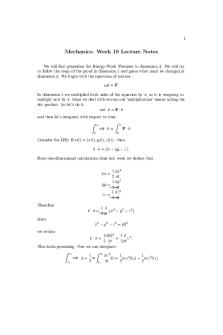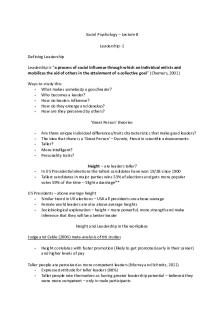Lecture 1 basics - Peter Corvi taught PDF

| Title | Lecture 1 basics - Peter Corvi taught |
|---|---|
| Course | Fundamentals of Finance |
| Institution | The University of Warwick |
| Pages | 4 |
| File Size | 409.6 KB |
| File Type | |
| Total Downloads | 93 |
| Total Views | 118 |
Summary
Peter Corvi taught...
Description
Professor Peter Corvi IB266 Fundamentals of Finance
Lecture 1
0. Basics Key Readings
Hillier, Ross et al. 9.1-9.6 Bodie et al. 5.4-5.5, 18.2
Introduction •
IB235 Finance 1 is mainly concerned with techniques for valuing financial assets – the same techniques will be applied in IB236 Finance 2 to value real assets used in capital projects
•
Examples of financial assets include equities, bonds and derivatives, and we will learn in this module how to value all three
•
In general, to calculate the fair value today of an asset, we need – to forecast the cash flows (e.g. dividends on shares, coupon payments on bonds) that the asset is expected to pay out in the future – a mechanism for expressing those expected future cash flows in so-called present-value terms 1
Risk •
We also need to recognise that assets in the real world are risky – this means that the size and timing of the future cash flows are uncertain
•
So we also have to have some means of modelling (and measuring) risk
•
Statistics provides some of the answers – best forecast of a future cash flow is the expected value (in the sense of the mean of the distribution of possible values) of that future cash flow – risk is measured by the variance (or equivalently its square root, the standard deviation) of the distribution of possible values for that future cash flow
•
How banks calculate compound interest provides a clue as to how to calculate present values – run compound interest calculation in reverse gear
Certain vs. Uncertain • •
•
•
We will start by assuming a world of certainty and learn how to discount future cash flows that are known today with certainty back to the present day We will then introduce risk – risk will be incorporated in our models by assuming that any one of a number of states are possible in the future We will assume that the payoff in each of these possible future states is known today with certainty – what we don’t know today is which of these states will occur at that point in the future – we will also assume that we know the probabilities that each of these states will occur What we will need to be able to calculate, then, are – the expected (in the sense of the probability-weighted average) future cash flow – the variance (and hence standard deviation) of possible values for that future cash flow
2
Different Outcomes • Uncertainty about future payoff Pt+1 is modelled by assuming there are a number of possible states 1, 2, … N next period with probabilities p1, p2, … pN time t
time t+1 state 1
P(1) t1
p1
P(2)1 t
p2 . .
Pt
state 2
. .
pN
P (N1 ) t
state N
• Probabilities sum to 1: π1 π2 ... π N 1 • Expected future payoff E[Pt+1] is given by: E[ P ] π P(1) π P(2) ... π Ν P( N ) t 1
1 t 1
2 t 1
t 1
• Variance var[Pt+1] of future payoffs:
2
(1)
(2)
2
(N )
2
E[P ] var[Pt 1 ] π1 P E[P ] π2 P E[P ] ... π Ν P t 1 t 1 t 1 t 1 t 1 t 1
Rates of Return •
Often, it will be more convenient to work in terms of returns rather than payoffs or cash flows
•
If we pay Pt today for a share of stock, hold on to it for one period in order to receive the dividend D t+1 that it pays at the end of that period, and then sell the share for P t+1 , our one-period rate of return Rt equals: Rt
(Pt 1 Pt ) Dt1 Pt
Pt 1 Dt 1 Pt (1 Rt )
•
There are two components to this rate of return – capital gain = (P t+1 -Pt)/Pt – dividend yield = Dt+1 /Pt
• •
This method of calculating rates of return is known as discrete compounding Continuously-compounded rates of return are calculated as follows (no dividends): P Rt ln t 1 Pt
R Pt 1 Pt e t
3
Example • Three equally-likely scenarios next period Scenarios: – “recession”, “normal”, “growth” • Two investment prospects – shares in car manufacturers, gold
• Sample calculations:
1. “Recession” 2. “Normal”
Rate of Return R Cars Gold -8% 20% 5% 3%
3. “Growth” 18% -20% Expected return 5% 1% Variance of returns 112.7%% 268.7%% Standard deviation 10.6% 16.4% [= variance]
E[ Rcars] 1 ( 8%) 1 (5%) 1 (18%) 5% 3 3 3 var[ Rcars] 1( 8% 5%) 2 1(5% 5%) 2 1 (18% 5%) 2 3 3 3 112.7%%
Summary •
We need to be able to value assets whose future payoffs are not known today with certainty
•
Two key issues – how do the future cash flows that the asset pays impact the value of the asset today? – how do we account for fact that these future cash flows are not known today with certainty?
•
The first issue requires us to adjust the future cash flows for the time value of money – this process of discounting future cash flows is the reverse of compounding and requires us to know (or estimate) the rate of return
•
The second issue requires us to – determine the expected value of the distribution of possible values for each future cash flow – adjust the rate of return that we use to discount these expected future cash flows for the level of risk associated with those cash flows
•
Risk is measured by variance (or standard deviation) of distribution of possible future cash flows
4...
Similar Free PDFs

FPGA-Basics - Lecture slides
- 17 Pages

ES 190 Lecture 1 Peter Howorth
- 2 Pages

MATS347 A1 basics - Lecture notes 1
- 31 Pages

HR lecture 9 - HR basics
- 6 Pages

1 Object Oriented Basics
- 3 Pages

1-Java Basics Review
- 4 Pages

Medical Terminology 1 Basics
- 13 Pages

Assignment 1 - WIRESHARK BASICS
- 6 Pages

ME312 Chapter 1 - Basics
- 31 Pages
Popular Institutions
- Tinajero National High School - Annex
- Politeknik Caltex Riau
- Yokohama City University
- SGT University
- University of Al-Qadisiyah
- Divine Word College of Vigan
- Techniek College Rotterdam
- Universidade de Santiago
- Universiti Teknologi MARA Cawangan Johor Kampus Pasir Gudang
- Poltekkes Kemenkes Yogyakarta
- Baguio City National High School
- Colegio san marcos
- preparatoria uno
- Centro de Bachillerato Tecnológico Industrial y de Servicios No. 107
- Dalian Maritime University
- Quang Trung Secondary School
- Colegio Tecnológico en Informática
- Corporación Regional de Educación Superior
- Grupo CEDVA
- Dar Al Uloom University
- Centro de Estudios Preuniversitarios de la Universidad Nacional de Ingeniería
- 上智大学
- Aakash International School, Nuna Majara
- San Felipe Neri Catholic School
- Kang Chiao International School - New Taipei City
- Misamis Occidental National High School
- Institución Educativa Escuela Normal Juan Ladrilleros
- Kolehiyo ng Pantukan
- Batanes State College
- Instituto Continental
- Sekolah Menengah Kejuruan Kesehatan Kaltara (Tarakan)
- Colegio de La Inmaculada Concepcion - Cebu






